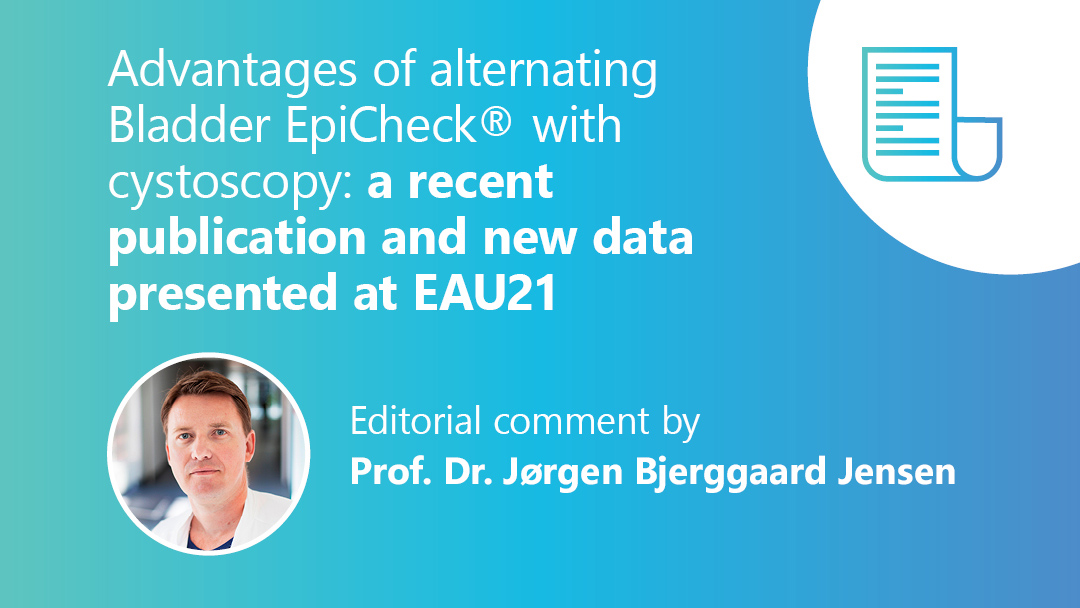Reviewed by Professor Jørgen Bjerggaard Jensen (Aarhus University Hospital, Aarhus, Denmark)
“A strategy alternating the urine marker Bladder EpiCheck® with cystoscopy in the surveillance of patients with low-grade intermediate-risk bladder cancer is cost-equivalent in the US and European countries.” [1]
“Thanks to Bladder EpiCheck®’s high high-grade sensitivity and specificity and a well-planned infrastructure, all high-grade/muscle-invasive tumours were detected while avoiding 76% of unnecessary cystoscopies.” [2]
Reduced burden on patients and healthcare systems
Due to the high frequency of recurrence in patients with non-muscle-invasive bladder cancer (NMIBC), surveillance is essential. The current guidelines recommend frequent cystoscopy and urine cytology. However, frequent cystoscopies pose a significant burden for both patients and healthcare systems.
A recent publication by Dr. Yair Lotan analysed the economic impact of alternating Bladder EpiCheck® with standard surveillance in patients with low-grade NMIBC across the U.S. and 9 European countries with varied healthcare cost structures [1]. The investigators developed a theoretical decision analysis model to compare standard surveillance with a modified surveillance schedule in which the Bladder EpiCheck® was alternated with cystoscopy plus cytology.
Alternating Bladder EpiCheck® with standard surveillance reduced the costs by €154 to €388 per patient over a period of 2 years in 7 countries. In the 3 other countries, the modified surveillance schedule resulted in a negligible cost increase (€33-103/patient over 2 years). The overall model cost reduction is driven by the high specificity of the Bladder EpiCheck®. Patients with a positive test result need to undergo a cystoscopy, which is an additional cost. A test with a high specificity has a low rate of false positive results and can therefore dramatically reduce the costs.
Another advantage of the modified approach is the reduced patient discomfort related to frequent cystoscopies.
Prospective studies will be necessary to validate these findings.
Read the publication here.
Or
Read a press release of the publication here.
Real-world evidence from the BE Home pilot
The BE Home pilot led by Prof. Witjes at Radboud University Medical Center assessed the feasibility and clinical outcomes of alternating a non-invasive urine test, Bladder EpiCheck®, with cystoscopy/cytology in a real-world setting [2].
In the BE Home pilot, 61 patients were given a kit with instructions for collection and shipment of a urine sample from home. When the sample arrived in a central lab, it was processed and results were sent to the hospital. The results and next steps were discussed by the urologist in a phone call with the patient:
- If the EpiCheck® results were positive → immediate cystoscopy was considered
- If the EpiCheck® results were negative → next follow-up visit according to the individual surveillance schedule of the patient
The test performance in 45 patients with ≥1 follow-up visit presented at EAU21 indicated a sensitivity of 100% for high-grade/muscle-invasive tumours and a specificity of 88%, leading to the avoidance of 76% unnecessary cystoscopies.
Selecting patients for an immediate or delayed cystoscopy based on the result of the Bladder EpiCheck® can reduce the frequency of unnecessary invasive procedures and hospital visits.
In these challenging COVID-19 times, alternating Bladder EpiCheck® with standard surveillance is also beneficial to avoid unnecessary exposure risk and to reduce burden on overloaded hospitals.
Watch the presentation here: short version (1 minute) or extended version (4.5 minutes).
Or
Read a press release of the presentation here.
References
- Lotan Y, Gakis G, Manfredi M, et al. Bladder Cancer 2021;doi:10.3233/blc-211528
- Witjes JA and Van Der Heijden AG. Presented at EAU 2021;abstract P0723
Share this on your favourite network:

